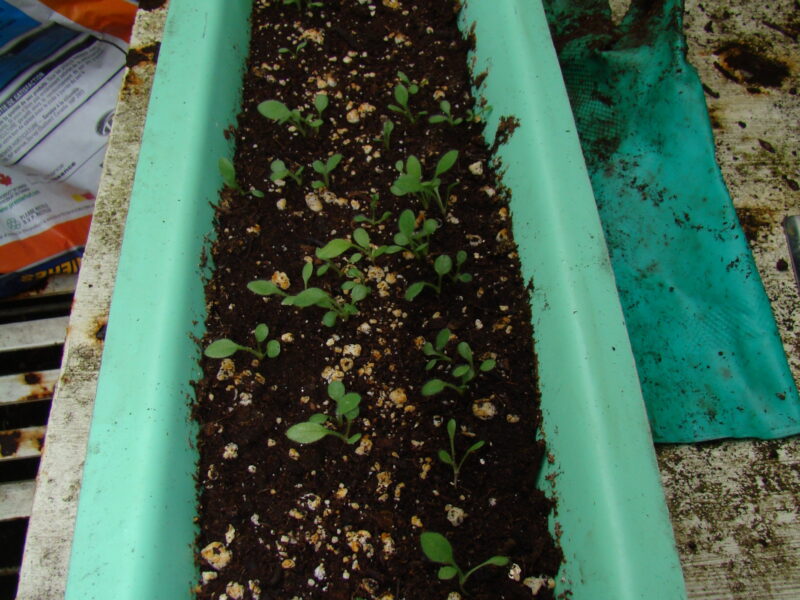

Yes, it’s February, and yes, it’s been a cold week. The calendar tells us that, date-wise, spring is only about seven weeks away. While the calendar may indicate that, I still think spring will be late and March will be cold and will be the month this year when we’re most likely to get snow.
Nonetheless, we are gardeners and eager to get our 2023 plants going and growing. Some of you will be sowing seeds indoors in the days to come for both the ornamental and veggie gardens, but here’s a suggestion: Rather than groan and moan in April that you started your seedlings too early, do a double sowing. If you’re growing tomatoes, peppers and other long-season crops and starting your seeds indoors, take the cautious route.
Start half your seeds when you normally would, but two to three weeks later start a second batch of the same seeds. This will be your hedge against a cold and wet spring with only half your seedlings getting leggy. Leggy isn’t always bad though. Tomato plants can always be planted deeper and even horizontally if you know how to trick the stem to grow vertically. Peppers on the other hand don’t appreciate this trick and can’t be planted deeper than usual.
Speaking of tomatoes, Johnny’s Selected Seeds had a webinar last month on the seed trade for tomatoes. Many of us are very picky about what tomatoes we like, and many varieties are not available at garden centers. However, there are hundreds of tomato varieties that you can grow from seed, opening up culinary and visual possibilities unknown to those who will only grow their tomatoes from a store-bought pot or cell pack.
The webinar, which you can find here, bit.ly/3XJftpH, while slightly slanted toward the market grower, was still fascinating. If you’ve got an hour to spare and tomatoes are one of your veggie garden faves, then check it out.
We were told at the very beginning that the webinar was not supposed to cover the topic of why tomatoes taste the way they do. New gardeners seem to put up with the taste of what they can or will grow. Those of us who have been at this for a while though are always complaining that tomatoes don’t have the taste that they used to.
I had to ask the question and voice my displeasure at what I’ve seen as an avoidance of this complaint while new varieties seem to show up by the dozens every year. The answer is sad but simple. But change is in the wind. Hopefully, it will reach the ground and us.
Tomato breeders are located all over the world, and no matter who you buy your tomato seed from the chances are pretty good that they didn’t grow or supply the plants that grew the tomatoes that the seeds come from. While it was noted that there is now a growing number of boutique and smaller growers who are more sensitive to our desire for a better (or even good) tasting tomato they are not quite there yet.
As home growers, we are low on the totem pole when it comes to the quantity of tomato seeds that we buy. Then there are the companies that can tomatoes, juice tomatoes, puree tomatoes and ship tomatoes to supermarkets and grocers. This is where the bulk of the seeds go, and these tomatoes need to be uniform, disease free, boxable, baggable and — in this age of greenhouse-grown veggies — have the ability to be grown in greenhouses called high tunnels. They are not for us home growers, and thus, our most important criteria, taste, is ignored. Check out the webinar.
There is another little secret about tomatoes that I’ve touched on in this column several times and one that may be an interesting opportunity for home growers who like to experiment. Enter the world of grafted tomatoes. Simply put, a grafted tomato is a tomato shoot of a superior quality that is grafted onto a tomato variety with superior root stock, thus eliminating many of the soil-borne disease issues that can plague these plants.
What you end up with is a fairly disease-free, often heirloom-type of tomato that has the potential for great taste. You can buy these plants already grafted at many garden centers or you can do it yourself. The results also provide you with a tomato plant that will fruit later and longer than its nongrafted relatives. Curious? Johnny’s has a video on how to do this, and you can find it here, bit.ly/408T7jd, but don’t dilly-dally as you need to grow your root and shoot plants indoors and start very soon.
One thing about tomato growing that most gardeners don’t consider is heat. For some reason we tend to think that these plants thrive in the heat. Well, they do, but to a point. Once the air temperature gets to 85 degrees most tomato varieties drop their buds, won’t set fruit and will stop flowering. We saw a lot of this last summer. The good news is that breeders are working on varieties that will be heat tolerant and will continue to flower and fruit at high temperatures. Ah, but about the taste? Stay tuned.
I’m running very late this year on getting my seed flats rebuilt and seeded so they can go outdoors. Many of the perennials I grow need a cold period to stimulate spring germination, and I like to get these flats outdoors when it’s mild (like last week) before it gets very cold again. Even better is when I can shovel snow onto these flats to keep them both cold and damp.
I can’t use plastic flats for this because they get brittle, crack and fall apart. For this reason I build my own wooden seed flats. However, it’s been very hard to find the wood I like to use so I’m scrambling to make repairs and use other wood species. Some garden centers sell wooden seed flats but they can run $15 to $20 or more, each. You can buy small cedar flats on Etsy (etsy.me/3WFILVb) for $15 and that may be all you need, but I like a flat that’s longer and a bit deeper. If you buy these flats and find that your soil slips through the bottom slat spaces there are two solutions. The first is to put a single sheet of newspaper on the bottom of the flat. For longer use you can take a custom cut piece of window screen and lay it across the bottom of the flat.
Those who follow and study ticks are warning us that the tick population, which usually gets knocked down a bit in cold winters, is alive and thriving. In their field surveys they are finding no lack of ticks in the landscape, on wild animals and on people based on the number of reported cases since early November. Dress appropriately, use the correct repellents (DEET and/or permethrin). Don’t think that since it’s winter your pet is protected. Keep protecting your dog as well.
If you read my column on weather stations before the holidays, I’ve got some important updates. I’ll write these up in a few weeks but if you’re considering buying one of these stations in the next month beware that there are some ice/snow issues with two of them and a power/solar panel issue. Send me an email and I’ll give you the details.
If you haven’t purchased your seeds yet, time is running out to get the best. Visit your local garden center or your favorite online vendor. I’m also noting “sold out” on many varieties in the plant catalogs and from online nurseries. Make sure you can get what you want by ordering early. And of course, keep growing.
 More Posts from Andrew Messinger
More Posts from Andrew Messinger